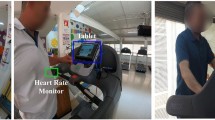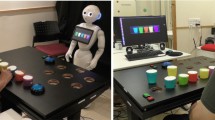Abstract
According to the world health organization, cardiovascular diseases are a major cause of death worldwide. Cardiac rehabilitation programmes are dedicated to approach this problem and reduce mortality rates due to the presence of a second event. However, the adherence and motivation of patients to assist to these programmes is not the expected. Therefore, this paper presents the incorporation of a SAR system into a cardiac rehabilitation scenario, where a social robot had the role of a training assistant during the therapy, aiming to increase motivation and encourage people to continue with the therapy. This study carried out a longitudinal experimental setup with a total of 209 sessions observed for a group of 6 patients in a period between 3 and 6 months. Results show that patients felt more encouraged to perform physical activity and continue with the rehabilitation when they perceived that monitored and supervised by the system, demonstrating that it can be implemented as a reliable tool that would potentially leverage tasks carried out by health professionals.







Similar content being viewed by others
Notes
The phrases presented here are translated from Spanish, which is the language used by the robot during the therapy.
Duration of the phase II might differ between patients, according to their physiological condition
References
World Heart Organization. Cardiovascular Disease. http://www.who.int/cardiovascular_diseases/en (2017). Accessed 3 Aug 2018
Bethell HJ, Turner SC, Evans JA, Rose L (2001) Cardiac rehabilitation in the United Kingdom. How complete is the provision? J Cardiopulm Rehabil 21(2):111
Sarrafzadegan N, Rabiei K, Shirani S, Kabir A, Mohammadifard N, Roohafza H (2007) Drop-out predictors in cardiac rehabilitation programmes and the impact of sex differences among coronary heart disease patients in an Iranian sample: a cohort study. Clin Rehabil 21(4):362
Worcester MU, Murphy BM, Mee VK, Roberts SB, Goble AJ (2004) Cardiac rehabilitation programmes: predictors of non-attendance and drop-out. Eur J Cardiovasc Prev Rehabil 11(4):328
Piepoli MF, Corrà U, Dendale P, Frederix I, Prescott E, Schmid JP, Cupples M, Deaton C, Doherty P, Giannuzzi P, Graham I, Hansen TB, Jennings C, Landmesser U, Marques-Vidal P, Vrints C, Walker D, Bueno H, Fitzsimons D, Pelliccia A (2017) Challenges in secondary prevention after acute myocardial infarction: a call for action. Eur J Cardiovasc Nurs 16(5):369
Bjarnason-Wehrens B, McGee H, Zwisler AD, Piepoli MF, Benzer W, Schmid JP, Dendale P, Pogosova NGV, Zdrenghea D, Niebauer J, Mendes M (2010) Cardiac rehabilitation in Europe: results from the European cardiac rehabilitation inventory survey. Eur J Cardiovasc Prev Rehabil 17(4):410. https://doi.org/10.1097/HJR.0b013e328334f42d
European Heart Network (2008) European cardiovascular disease statistics. http://www.ehnheart.org/cvd-statistics/cvd-statistics-2017.html. Accessed 22 Nov 2018
Taylor RS, Unal B, Critchley JA, Capewell S (2006) Mortality reductions in patients receiving exercise-based cardiac rehabilitation: how much can be attributed to cardiovascular risk factor improvements? Eur J Cardiovasc Prev Rehabil 13(3):369. https://doi.org/10.1097/01.hjr.0000199492.00967.11
Michie S, O’Connor D, Bath J, Giles M, Earll L (2005) Cardiac rehabilitation: the psychological changes that predict health outcome and healthy behaviour. Psychol Health Med 10(1):88. https://doi.org/10.1080/13548500512331315398
Taylor C, ME Y, D C et al (2005) Effects of antidepressant medication on morbidity and mortality in depressed patients after myocardial infarction. Arch Gen Psychiatry 62(7):792
Anderson L, Oldridge N, Thompson DR, Zwisler AD, Rees K, Martin N, Taylor RS (2016) Exercise-based cardiac rehabilitation forcoronary heart disease: Cochrane systematic review and meta-analysis. J Am Coll Cardiol 67(1):1. https://doi.org/10.1016/j.jacc.2015.10.044
Graham IM, Fallon N, Ingram S, Leong T, Gormley J, O’Doherty V, Maher V, Benson SE (2011) Rehabilitation of the patient with coronary heart disease. Hurst’s Heart 13:1–33
Yu CM, Lau CP, Chau J, McGhee S, Kong SL, Cheung BMY, Li LSW (2004) A short course of cardiac rehabilitation program is highly cost effective in improving long-term quality of life in patients with recent myocardial infarction or percutaneous coronary intervention. Arch Phys Med Rehabil 85(12):1915. https://doi.org/10.1016/j.apmr.2004.05.010
Jack K, McLean SM, Moffett JK, Gardiner E (2010) Barriers to treatment adherence in physiotherapy outpatient clinics: a systematic review. Manual Ther 15(3):220. https://doi.org/10.1016/j.math.2009.12.004
Ferreira C, Guimarães V, Santos A, Sousa I (2014) In: proceedings of the 8th international conference on pervasive computing technologies for healthcare (ICST (Institute for Computer Sciences, Social-Informatics and Telecommunications Engineering), ICST, Brussels, Belgium, Belgium, 2014), PervasiveHealth ’14, pp 282–285. http://doi.org/10.4108/icst.pervasivehealth.2014.255326
Su CH, Cheng CH (2016) Developing and evaluating creativity gamification rehabilitation system: the application of PCA-ANFIS based emotions model. Eurasia J Math Sci Technol Educ 12(5):1443. https://doi.org/10.12973/eurasia.2016.1527a
Riva G (2005) Virtual reality in psychotherapy: review. Cyber Psychol Behav 8(3):220
Ding D, Liu HY, Cooper R, Cooper RA, Smailagic A, Siewiorek D (2010) Virtual coach technology for supporting self-care. Phys Med Andrehabil Clin North Am 21(1):179–194. https://doi.org/10.1016/j.pmr.2009.07.012
Fridin M (2014) Storytelling by a kindergarten social assistive robot: a tool for constructive learning in preschool education. Comput Educ 70:53. https://doi.org/10.1016/j.compedu.2013.07.043
Han J, Jo M, Jones V, Jo JH (2008) Comparative study on the educational use of home robots for children. J Inf Process Syst 4(4):159. https://doi.org/10.3745/JIPS.2008.4.4.159
Tapus A, Mataric MJ, Scassellati B (2007) Socially assistive robotics [grand challenges of robotics]. IEEE Robot Autom Mag 14(1):35. https://doi.org/10.1109/MRA.2007.339605
Breazeal C (2011) In: 2011 annual international conference of the IEEE Engineering in Medicine and Biology Society, pp 5368–5371. https://doi.org/10.1109/IEMBS.2011.6091328
Robinson H, MacDonald B, Broadbent E (2014) The role of healthcare robots for older people at home: a review. Int J Social Robot 6(4):575. https://doi.org/10.1007/s12369-014-0242-2
French B, Tyamagundlu D, Siewiorek DP, Smailagic DP, Ding D (2008) In: 2008 12th IEEE international symposium on wearable computers , pp 77–80. https://doi.org/10.1109/ISWC.2008.4911589
Sebastian J, Richards D (2017) Changing stigmatizing attitudes to mental health via education and contact with embodied conversational agents. Comput Hum Behav 73:479
Bickmore T, Utami D, Zhou S, Sidner C, Quintiliani L (2015) In: Brinkman WP, Broekens J, Heylen D (eds) Intelligent Virtual Agents. Springer, Cham, pp 260–269
IJsselsteijn WA, Kort YAW, Westerink J, Jager M, Bonants R (2006) Virtual fitness: stimulating exercise behavior through media technology. Presence Teleoperators Virtual Environ 15(6):688. https://doi.org/10.1162/pres.15.6.688
Bickmore TW, Silliman RA, Nelson K, Cheng DM, Winter M, Henault L, Paasche-Orlow MK (2013) A randomized controlled trial of an automated exercise coach for older adults. J Am Geriatr Soc 61(10):1676. https://doi.org/10.1111/jgs.12449
Feil-Seifer D, Mataric MJ (2005) In: 9th international conference on rehabilitation robotics, 2005. ICORR 2005, pp 465–468. https://doi.org/10.1109/ICORR.2005.1501143
Matarić MJ, Eriksson J, Feil-Seifer DJ, Winstein CJ (2007) Socially assistive robotics for post-stroke rehabilitation. J NeuroEng Rehabil 4(1):5
Bemelmans R, Gelderblom GJ, Jonker P, de Witte L (2012) Socially assistive robots in elderly care: a systematic review into effects and effectiveness. J Am Med Dir Assoc 13:114–120
Tsardoulias EG, Kintsakis AM, Panayiotou K, Thallas AG, Reppou SE, Karagiannis GG, Iturburu M, Arampatzis S, Zielinski C, Prunet V, Psomopoulos FE, Symeonidis AL, Mitkas PA (2017) Towards an integrated robotics architecture for social inclusion—the RAPP paradigm. Cognitive Syst Res 43:157. https://doi.org/10.1016/j.cogsys.2016.08.004
Louie WY, McColl D, Nejat G (2014) Acceptance and attitudes toward a human-like socially assistive robot by older adults. Assist Technol 26(3):140
Conti D, DiNuovo S, Buono S, DiNuovo A (2017) Robots in education and care of children with developmental disabilities: a study on acceptance by experienced and future professionals. Int J Soc Robot 9(1):51
Feil-Seifer D, Matarić MJ (2009) In: Khatib O, Kumar V, Pappas GJ (eds) Robotics experimental. Springer, Berlin, pp 201–210
Rabbitt SM, Kazdin AE, Scassellati B (2015) Integrating socially assistive robotics into mental healthcare interventions: applications and recommendations for expanded use. Clin Psychol Rev 35:35. https://doi.org/10.1016/j.cpr.2014.07.001
Martín F, Agüero CE, Cañas JM, Valenti M, Martínez-Martín P (2013) Robotherapy with dementia patients. Int J Adv Rob Syst 10:10
Shen Z, Wu Y (2016) Investigation of practical use of humanoid robots in elderly care centres. In: Proceedings of the fourth international conference on human agent interaction—HAI ’16, pp 63–66
Süssenbach L, Riether N, Schneider S, Berger I, Kummert F, Lütkebohle I, Pitsch K (2014) In: The 23rd IEEE international symposium on robot and human interactive communication, pp 286–293
Kang KI, Freedman S, Matarći MJ, Cunningham MJ, Lopez B (2005) A hands-off physical therapy assistance robot for cardiac patients. In: 9th international conference on rehabilitation robotics, 2005. ICORR 2005, pp 337–340. https://doi.org/10.1109/ICORR.2005.1501114
Pfeifer R, Scheier C (1999) Understanding intelligence. MIT Press, Cambridge
Dautenhahn K, Ogden B, Quick T (2002) From embodied to socially embedded agents-implications for interaction-aware robots. Cognitive Syst Res 3(3):397. https://doi.org/10.1016/S1389-0417(02)00050-5
Kennedy J, Baxter P, Belpaeme T (2015) Comparing robot embodiments in a guided discovery learning interaction with children. Int J Soc Robot 7(2):293
Belpaeme T, Baxter P, Read R, Wood R, Cuayáhuitl H, Kiefer B, Racioppa S, Kruijff-Korbayová I, Athanasopoulos G, Enescu V, Looije R, Neerincx M, Demiris Y, Ros-Espinoza R, Beck A, Cañamero L, Hiolle A, Lewis M, Baroni I, Nalin M, Cosi P, Paci G, Tesser F, Sommavilla G, Humbert R (2013) Multimodal child–robot interaction: building social bonds. J Hum Robot Interact 1(2):33. https://doi.org/10.5898/JHRI.1.2.Belpaeme
Wainer J, Feil-seifer D, Shell DA, Mataric MJ (2006) In: ROMAN 2006—the 15th IEEE international symposium on robot and human interactive communication, pp 117–122. https://doi.org/10.1109/ROMAN.2006.314404
Powers A, Kiesler S, Fussell S, Torrey C (2007) In: Proceedings of the ACM/IEEE international conference on human–robot interaction, HRI ’07. ACM, New York, pp 145–152. https://doi.org/10.1145/1228716.122873
Scherr J, Wolfarth B, Christle JW, Pressler A, Wagenpfeil S, Halle M (2013) Associations between Borg’s rating of perceived exertion and physiological measures of exercise intensity. Eur J Appl Physiol 113(1):147
Lara J.S., Casas J, Aguirre A, Munera M, Rincon-Roncancio M, Irfan B, Senft E, Belpaeme T, Cifuentes CA (2017) In: 2017 international conference on rehabilitation robotics (ICORR) (2017), pp 1013–1018
Casas J, Irfan B, Senft E, Gutiérrez L, Rincon-Roncancio M, Munera M, Belpaeme T, Cifuentes CA (2018) In: Companion of the 2018 ACM/IEEE international conference on human-robot interaction, HRI ’18. ACM, New York), pp 79–80
Achten J, Jeukendrup AE (2003) Heart rate monitoring. Sports Med 33(7):517
Funding
This work was supported in part by the Royal Academy of Engineering IAPP project Human–Robot Interaction Strategies for Rehabilitation based on Socially Assistive Robotics (Grant IAPP/1516/137), the EU H2020 MSC ITN project APRIL (Grant 674868), the EU FP7 project DREAM (Grant 611391) and Colciencias (Grant 813-2017).
Author information
Authors and Affiliations
Corresponding author
Ethics declarations
Conflict of interest
The authors report no conflict of interest.
Additional information
Publisher's Note
Springer Nature remains neutral with regard to jurisdictional claims in published maps and institutional affiliations.
Rights and permissions
About this article
Cite this article
Casas, J., Senft, E., Gutiérrez, L.F. et al. Social Assistive Robots: Assessing the Impact of a Training Assistant Robot in Cardiac Rehabilitation. Int J of Soc Robotics 13, 1189–1203 (2021). https://doi.org/10.1007/s12369-020-00708-y
Accepted:
Published:
Issue Date:
DOI: https://doi.org/10.1007/s12369-020-00708-y




